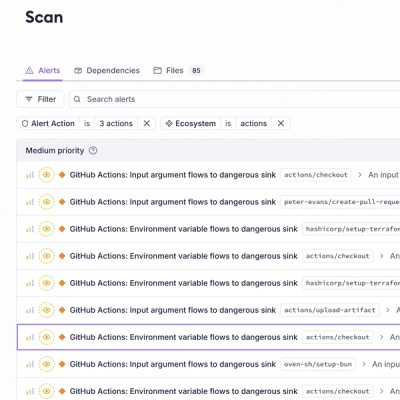
Product
Introducing Socket Firewall Enterprise: Flexible, Configurable Protection for Modern Package Ecosystems
Socket Firewall Enterprise is now available with flexible deployment, configurable policies, and expanded language support.
svg-sprite-generation-loader
Advanced tools
Webpack loader for generating external svg symbol sprite files
Webpack loader for generating external svg symbol sprite files
svg-sprite-generation-loader is a webpack-loader that takes a multiple svg files, optimize them (using svgo.optimize), transform (parse and return as an object with symbolId, attributes and content (disabled by default) keys) and put them back in one file.
Input multiple svg files, e.g:
<!-- file1.svg -->
<svg viewBox="0 0 10 10">
<!-- file1.svg content -->
</svg>
<!-- file2.svg -->
<svg viewBox="0 0 10 30">
<!-- file2.svg content -->
</svg>
<!-- file3.svg -->
<svg viewBox="0 0 15 40">
<!-- file3.svg content -->
</svg>
Output one svg file (svg sprite):
<svg xmlns="http://www.w3.org/2000/svg">
<symbol viewBox="0 0 10 10" id="file1">
<!-- file1.svg content -->
</symbol>
<symbol viewBox="0 0 10 30" id="file2">
<!-- file1.svg content -->
</symbol>
<symbol viewBox="0 0 15 40" id="file3">
<!-- file3.svg content -->
</symbol>
</svg>
You can refer to this file to display all your icons using SVG stacking technique
npm install svg-sprite-generation-loader --save-dev
yarn
yarn add svg-sprite-generation-loader --dev
In your webpack config:
const SvgSpriteGenerationPlugin = require('svg-sprite-generation-loader/plugin.js');
module.exports = {
plugins: [new SvgSpriteGenerationPlugin()],
module: {
rules: [
{
test: /\.svg$/,
use: 'svg-sprite-generation-loader',
},
],
},
};
In some source code:
import iconData from 'path/to/some/icon-file-name.svg';
// by default iconData will include symbolId and attributes keys.
// If you enable the addContent loader option, the `content` key will also be added
<svg {...iconData.attributes}>
<use href={`path/to/sprite/filename.svg#${iconData.symbolId}`} />
</svg>;
| Name | Type | Default value | Description |
|---|---|---|---|
| symbolId | string | function | "[name]" | Sprite item (single icon) <symbol> id attribute value.string or function that takes the file path of the original icon as an argument and returns string.You can use interpolateName patterns. Default value ( "[name]") is equal to icon filename (without extension). For example, by default symbolId for file1.svg file will be file1 |
| spriteFilePath | string | sprite.svg | Path to sprite file.webpack.output.path is included. You can use interpolateName patterns. |
| svgoOptimize | boolean | object | true | Enable/Disable/Customize source svg file optimization with svgo.optimize. The following options are used by default: You can disable it completely (by passing false) or use your own configuration (see svgo docs) |
| addContent | boolean | false | Add svg content as property to transformed svg object (may increase bundle size when enabled) |
FAQs
Webpack loader for generating external svg symbol sprite files
The npm package svg-sprite-generation-loader receives a total of 1,257 weekly downloads. As such, svg-sprite-generation-loader popularity was classified as popular.
We found that svg-sprite-generation-loader demonstrated a healthy version release cadence and project activity because the last version was released less than a year ago. It has 1 open source maintainer collaborating on the project.
Did you know?

Socket for GitHub automatically highlights issues in each pull request and monitors the health of all your open source dependencies. Discover the contents of your packages and block harmful activity before you install or update your dependencies.

Product
Socket Firewall Enterprise is now available with flexible deployment, configurable policies, and expanded language support.

Security News
Open source dashboard CNAPulse tracks CVE Numbering Authorities’ publishing activity, highlighting trends and transparency across the CVE ecosystem.

Product
Detect malware, unsafe data flows, and license issues in GitHub Actions with Socket’s new workflow scanning support.